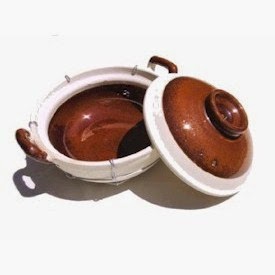Below are the traditional tools and utensils which have been used in Thai kitchens for years. These items were originally brought by Thai ancestors who migrated from China to the northern part of Thailand. If you will walk into a traditional Thai kitchen, here are some of the common cooking tools you would find:
• Strainer: This is handy for straining liquids and grease from much food.
• Coconut Grater: Since coconut is used so extensively in Thai cooking, this utensil is almost a necessity and used by every housewife in Thailand.
• Chopping Block/Board: A wooden block for cutting meats and fishes.
• Glutinous Rice Basket: This tightly woven basket keeps sticky rice warm and moist, preserving it for a surprisingly long time without refrigeration.
• Mortar and Pestle: The mortar is made of crude earthenware, stone or hardwood, and is deep with a weighted base. The pestle is chunky. They are especially designed to cope with the moist curry pastes and for bruising lemon grass, citrus rind, garlic and coriander roots.
• Stove: This is the crude charcoal stoves, built of clay. The insert holds a wok or pot. In small villages charcoal stoves are the main source of cooking heat. The hole at the bottom allows air to flow in Bamboo Rice Steamer.
• Skewer: Usually made of bamboo. One end of the skewer is sharp and pointed, and meat and vegetables can be speared on it and cooked in shish-kebob style.
• Wok: This is easier to clean and distributes heat more evenly than a conventional frying pan. It is also less likely to be damaged. Used for conventional frying, stir-frying and deep-fat frying.
• Coconut Shell Spoon: A simple spoon with a wooden handle, which comes in many sizes. There are also similar utensils made with halves of coconut shells, used as ladles.
• Curry Pot: This clay pot has large handles on the sides that curve up above the level of the lid, which makes it easy to carry. As the name implies, it is used for the large variety of curries which the Thai people enjoy.
• Steamer: This is made of clay or aluminum, and fits atop the mouth of the charcoal burner.
Since the Thai eat rice with every meal, a steamer is not a luxury, but a part of every kitchen in Thailand. (In fact, in Thai, the verb “to eat” is “gkin kao” which literally means “to eat rice”)
The kitchen in Thailand is a very simple, which is generally built away from the main house. It is a plain room, with a cement or dirt floor, with unglazed windows which might boast the luxury of screens to keep out the mosquitoes, although many do not even have a door, let alone window screens. In the central region, Thai homes are elevated on teak poles because of yearly flooding throughout the late rainy season from September till end of October.
The central feature of the kitchen is the stove, which is generally built-in, and constructed of cement or brick. It has a large aperture below to insert and remove the charcoal pot, a funnel shaped vessel of kiln-baked earthenware or a cement-lined metal pail that holds the burning charcoal. When the charcoal pot is in place, it fits directly below a circular opening in the top of the stove. This hole has flanges which hold a ‘wok’ (the traditional round-bottomed Asian frying pan) firmly in place above the charcoal fire. Extra charcoal is kept in a box or a sack beside the stove. In poorer households, they will simply use the charcoal pot, made with flanges on the top, as the stove.
Because there are no oven arrangements, there is no baking in the home, and in the entire range of Thai cuisine there are almost no baked dishes to be found.











This article reflects how rich Thai culture is when it comes to cooking.
ReplyDelete